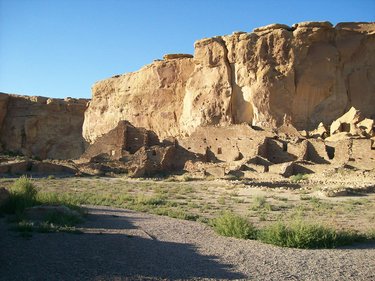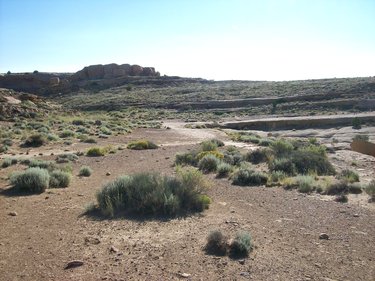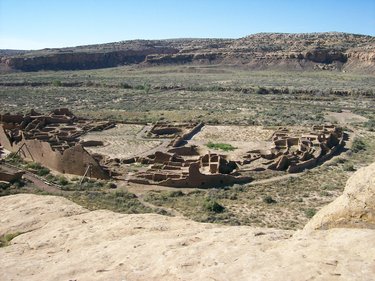Chaco Canyon is a geological and archeological enigma
Chetro Ketl, a ruin at Chaco, shows a change that can be seen elsewhere in the canyon and in many other Anasazi sites: There is an imposing colonnaded wall of a building that resembles features found in Mayan buildings far to the south in Mexico and was perhaps inspired by them. But the spaces between the columns have been walled up.
If the name “Chaco Canyon” is unfamiliar or unknown to you, do not be surprised. I have found that very few people east of the Mississippi have heard of it. For that matter, I have run into very few people west of the Mississippi who know of it, even in the state of New Mexico in which it is located. (Of course, according to New Mexico Magazine, the number of people in this country who do not know that New Mexico is one of the 50 states is stunning — but we’ll let that go!)
Situated at the end of a bone-rattling 20-mile-long dirt road for which the expression “washboard surface” must have been coined, Chaco Canyon lies scores of miles west and north of Santa Fe, in a starkly beautiful stretch of desert. Blisteringly hot in the summer, achingly cold in the winter, it represents a section of high desert plateau incised many millions of years ago by a great river at a time when that part of the United States was far wetter than it is now.
Find Chaco on Google Earth and you will see that long-vanished river’s meandering course. Today the only water that runs through Chaco occurs when the heavy rains known as “monsoons” surge through the canyon in late summer, or when occasional winter snows melt. Then a muddy little stream known as Chaco Wash may flow briskly for a while, a pathetic reminder of the great river that millions of years ago cut its way down through the ancient rock strata of the plateau.
But there are many such canyons in New Mexico, Colorado, Arizona, and Utah. What makes Chaco important for more than its spectacular Martian scenery is the fact that a thousand years ago and before, it was the site of feverish building activity by the mysterious people long known as the Anasazi.
The term is Navajo and it is often translated as “ancient ancestors,” but it may also be rendered as “ancient enemy.” These days, in some quarters, the term has been dropped in favor of the more politically correct expression “ancestral Pueblo people,” but, as the evocative name “Anasazi” occurs frequently in the archeological literature, it seems appropriate to use it in this essay — which, after all, deals with the enigmas of Chaco Canyon.
The strata or “rock layers” of Chaco date from the Cretaceous Period of Earth’s history, and are roughly 80 million years old. They record a time when a vanished body of water known as the “Western Interior Seaway” covered this area.
It is a strange experience to hike the top of the plateaus surrounding Chaco Canyon and see fossils of corals, worm tubes, and shellfish in the rock layers that shimmer in the relentless heat of a New Mexican summer and to try to imagine the turquoise-blue sea that once covered the region.
And what would the ancient people have thought of them? The strata are composed of sandstone and shale — the latter sometimes mixed with poor-quality coal, forming black bands in the stark cliffs. Shales here as most everywhere are crumbly and brittle, but the sandstone is what geologists call “competent”: It is hard and makes excellent building stone. And here, starting in at least 800 A.D. and perhaps before, the mysterious Anasazi people settled and began to build.
Many United States travelers are familiar with Mesa Verde National Park in Colorado, where the Anasazi built their magnificent cliff dwellings. But there are many other such sites: Hovenweep, Canyon de Chelley, Navajo National Monument, and the Ute Tribal Park, to name just a few.
There, in the shallow shelters at the base of hard sandstone cliffs, these ancient people ingeniously constructed their stone villages, carefully fitting shards of rock together with the precision of the finest masons. The rocky overhangs offered protection from the fierce Southwestern sun as well as wind, snow, and rain.
But their lofty locations also offered protection from intruders — at least until some time around the year 1200 when something catastrophic happened. But more of this later.
What makes Chaco different from the other Anasazi dwelling places — and spectacular — is that here these people chose mainly to build sprawling free-standing buildings, some of them four stories high. In Chaco Canyon proper, there are at least a dozen such sites — and in the plateaus around it are many more.
Some of them are enormous, the largest being Pueblo Bonito, a great D-shaped structure featuring hundreds of rooms and dozens of kivas (round ceremonial pits). At its height, it may have been home to over one-thousand residents.
Adjacent to it and in various other areas of the canyon floor and the mesas above it, are many more such structures, varying in shape and size and building techniques, but all of them constructed from the billions of flat-rock fragments that weather from the cliffs and the surface bedrock, chinked with mud for mortar. They often form artful patterns, which in some cases may have been intended to mimic the patterns the Anasazi saw in the bedrock.
What is surprising is that the builders then apparently covered the walls with adobe, hiding their carefully crafted patterns. Perhaps they were motivated by the same impulse that drove the builders of Medieval cathedrals to insist on perfection even in those architectural details beyond the sight of worshippers on the grounds that they were intended for the eyes of the Almighty.
In any case, visitors to Chaco wander through the ruins in admiration of the sheer muscle power that must have been expended on their construction. Even in their ruined state, they inspire awe.
The making of myth
But it is the very vastness of the ruins that raises one of the questions that have troubled archeologists since the first Spanish explorers stumbled upon them in the mid-Seventeenth Century: For what purpose were these enormous buildings constructed?
The ruins in many of the other Anasazi sites were clearly occupied by extended family groups or tribes. In some of these sites, dried gourds and desiccated fragments of squash, beans, and corn may be found still in the places where the occupants left them —apparently having abandoned the structures on very short notice.
But vast areas of some of the pueblos at Chaco — in particular Pueblo Bonito — show few or no signs of habitation, having been meticulously constructed but apparently never occupied or even used for storage. And yet the ancient builders cleared an enormous network of roads stretching over 400 miles that radiate from Chaco, suggesting that this was meant to be an important hub of trade, religion, habitation — or perhaps all three.
And there have been additional discoveries that are disturbing. Beneath the dirt floors of some of the ground-story rooms, archeologists have found human bones that appear to have been systematically butchered, raising the frightening possibility of cannibalism, though some Native American Indians have insisted that these are more likely signs of rituals aimed at suspected witches. The issue is incendiary among modern pueblo people.
In addition, large quantities of jewelry and pottery have been found buried within the ruins, suggestive perhaps of attempts to hide them from invaders.
Curiously, in the Chaco region and in many other Anasazi sites, nothing remotely suggestive of a cemetery has been discovered — puzzling for a location that could potentially have had thousands of inhabitants.
Or could it? Given the fact that the land and climate a thousand years ago were not much different from those of today, farming would have been a daunting challenge; and, although the Anasazi were experts at what is known as “dry farming,” there are few areas of the floor of Chaco Canyon that show traces of the extensive cultivated fields of corn, beans, and squash that can be seen at Mesa Verde and other Anasazi sites.
There is some wild game — jack rabbits and some elk — but the sparse desert environment would hardly have allowed the existence of vast numbers of either animal.
So the questions remain: If the Chaco ruins were once occupied by great numbers of individuals, these people would have required enormous quantities of water; what was its source? How did the inhabitants raise or hunt enough food to survive? Where did they bury their dead? And what exactly drew people to Chaco from great distances along the broad roads?
One tantalizing hint comes from the so-called “Sun Dagger” site located on the magnificent outcrop known as Fajada Butte. Rising hundreds of feet from the floor of the canyon, the butte can be seen from over 20 miles away on clear days.
Though climbing it is prohibited to visitors, on its upper slopes archeologists have found three enormous slabs of rock carefully placed so that at each of the solstices and the equinoxes, sunlight moving through a slit in the rock is cast in various patterns on a spiral sun symbol, one of them knife-shaped.
Moreover, a number of the ancient pueblos have central features that seem to be aligned toward positions where the sun rises at various times of the year, evoking Stonehenge.
Combined with other things hinted at in Chaco, it raises the possibility that the canyon might have been occupied briefly for trade and religious rituals at specified times of the year and then stood largely empty for long periods.
But one looks at all of that has been written about Chaco Canyon and sees the words “suggestive of,” “possibility,” “perhaps,” “hints at,” “could have,” “might have” — and realizes that there is much that is unknown, and that may never be known, about this and other sites of the ancient pueblo people.
They did not have a written language, and all that is known about them has been passed down orally from one generation to the next by tribal elders. And, one-thousand years is a long time for historic events to become legend and then myth.
Mysteries of Chaco
Perhaps the most daunting question that arises when dealing with the Anasazi is why all of their meticulously constructed buildings were abandoned starting in the 1200s.
Tree rings record the onset of an extensive drought — but in addition to the fact that severe droughts are cyclical in the Southwest, this would hardly explain the apparent sudden abandonment of the ancient structures. All the signs indicate that at Chaco, Mesa Verde, Canyon de Chelley, and elsewhere, a time came in which the people simply grabbed whatever they could carry, damaged or destroyed what they could not take with them, and vanished into the deserts.
One particular ruin called Chetro Ketl at Chaco shows a change that can be seen elsewhere in the canyon and in many other Anasazi sites: There is an imposing colonnaded wall of a building that resembles features found in Mayan buildings far to the south in Mexico and was perhaps inspired by them. But the spaces between the columns have been walled up. And, as one explores the other ruins both on the canyon floor and on the mesas above it, one sees this process repeated: windows and doorways that have been subsequently filled with masonry.
Was this done simply for the purpose of strengthening the structures? Or combined with other unsettling facts about the ancient people, does it suggest an increasing need for security from attackers? Add these to the unanswered questions about Chaco.
Hike reveals more to ponder
One morning before the heat of midday came, along with a friend from Colorado, I set off to hike the plateau on the west side of the canyon. Carried on the dry morning wind were the combined smells of sage and juniper — what some have termed “desert incense.”
Our goal was the ruin called Tsin Kletsin, which lay at the end of a mile-and-a-half trail that led steeply at first up a series of switchbacks on some jagged cliffs and then over a much gentler slope dotted with Pinyon pines and juniper trees. The only animal life we observed consisted of some buzzards circling overhead — perhaps they were hoping we would be their next meal — and a rather emaciated-looking jack rabbit. We were glad we did not have to depend on wild game for meals.
For whatever reason, Chaco Canyon was nearly empty of visitors that day and we were the only hikers. The landscape below us was — as is most of Chaco — starkly beautiful, with tawny-colored cliffs, enormous piles of talus at their bases, and great embayments in the mesas, in which were nestled many of the ancient ruins.
But Tsin Kletsin was built at the high point of a dusty, windy stretch of desert, its fallen walls brooding darkly against the deep blue sky.
Like many of the other ruins, much of it is still unexcavated, with only a few of the remaining tiers of rock visible to give a sense of its general outline: rectangles and squares, covering thousands of square feet, and the inevitable circular kivas, all of them filled with shallow layers of dirt deposited over the centuries.
In places, small fragments of the Anasazi people’s distinctive black-on-white pottery lay amid the debris on the ground. The stone walls were surrounded by miles of parched landscape dotted with sage and cactuses and occasional junipers or Pinyon pines, some of them long dead and picturesquely twisted and blackened.
And it was there that another of the mysteries of Chaco struck us: Where did the builders get all of the stone to build Tsin Kletsin and some of the other ruins high on the mesas?
The pueblos on the canyon floor required enormous amounts of manpower, but at least the builders’ materials were lying everywhere at the base of the cliffs. But both Tsin Kletsin and a neighbor called Pueblo Alto on the distant north plateau lie a mile and a half from an easily available stone source.
What political or religious ideal could have driven the ancient workers to carry to this remote location the thousands of tons of stone required to raise these buildings? Yet another bewildering point to ponder.
Deep, dark skies
Chaco Canyon has always been known also as a place for lovers of the night sky, and, on Aug. 28, the International Dark Skies Association designated Chaco as the newest Dark Sky Park — a place where a viewer can get away from all artificial light and see the stars as our ancestors saw them.
The nights we camped in Chaco’s rather primitive campground we saw those fiery, cloud-flecked sunsets for which the West is celebrated, and we watched as the sky turned deep azure, then violet, and finally a black unblemished by the haze of cities or the humidity of other climates. Within it, the stars blazed brilliantly, showing shades of red and amber and blue.
The campground is situated close to Chaco Canyon’s north plateau, and at its foot are the ruins of two of the few actual cliff dwellings at Chaco. They are small, no more than fifteen feet square, and they are empty and dusty.
But their walls reflect the pale light of the stars and somehow in the night the tiny pueblos seem to be of this time and not ancient: Through their dark window holes, one expects to see the glow of a cook fire.
But it does not appear.
From the plateau above come the occasional howl of coyotes and the cool evening air is scented with sage and other desert plants; then the realization comes that one is experiencing the sights and the sounds and the smells of night just as the Anasazi did a thousand years ago.
And what had drawn them here? And where and why did they go? And what thoughts entered their minds when they looked up at the gleaming stars?
These and so many other questions frame the haunting mysteries of Chaco Canyon.




